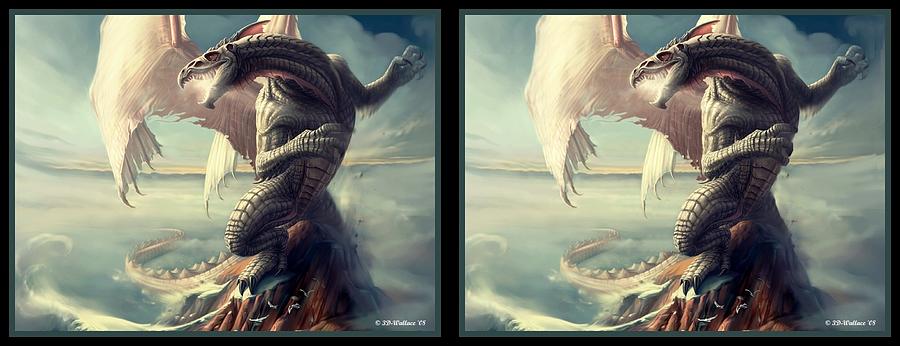
Massive Dragon - Gently cross your eyes and focus on the middle image

by Brian Wallace
Title
Massive Dragon - Gently cross your eyes and focus on the middle image
Artist
Brian Wallace
Medium
Digital Art - 3d Stereo Crossview Conversion
Description
2D to 3D conversion of an image found on the web. To view the stereo depth, gently converge (cross) your eyes and focus on the middle image that appears while ignoring the outside.
Uploaded
September 12th, 2011
Statistics
Viewed 2,134 Times - Last Visitor from Ottawa, ON - Canada on 04/17/2024 at 12:00 AM
Embed
Share
Sales Sheet
Comments (14)

Brian Wallace
LOL, as long as you find it interesting and enjoy viewing them. I'm just happy that you're able to freeview the image successfully. About 6 years ago I joined several Yahoo web groups for anaglyphs and crossview (sometimes known as crosseye or X-Eye) 3D stereo formats. I developed a passion and have learned a great deal from others around the world and through my own experimentation. The 2D-3D conversion process I used for this image was one I developed myself using the freeware app that is widely used for aligning 3D stereos once they added a cloning tool to the application. The technique of shifting pixels for this purpose is not new, but I developed a process (and tutorial) to be used for this particular application.

Carolyn Marshall
I see what you mean, Brian. Yes, it does sound complicated. You lost me after - there are special techniques that ... LOL! Thank you for explaining, though. It is a very interesting subject to me and amazes me every time I see one done like this.

Brian Wallace
Thank you Xueling, and E Giupponi also for your comments which are very appreciated. :)

Brian Wallace
Not unless you have some unknown condition I don't know about. Thanks for the response!

Brian Wallace
Thank you for your kind message Erica. Not everyone can view "side-by-side" 3D stereo formats even with two good eyes. They can however just view one side as a "2D" image even if they need to hide the other side from view. I'm sorry you lost sight in your right eye. You have an amazing image gallery!

EricaMaxine Price
Congrats on your sale Brian. I love this piece. Dragons, wizards, castles, and so on are part of my collection of miniatures. Unfortunately I lost sight in my right eye so I can't see the 3D.

Brian Wallace
There are special techniques which would be a little too lengthy to describe in detail here but... This is a 2D to 3D conversion. I took one "normal" 2D image and shifted the pixels to form another image that views as if it's from a slightly different angle. The two images are kept in alignment. The left eye views the right image and the right eye views the left image and the viewer experiences depth perception. I have other "side-by-side" crossview images in my gallery which view the same way but are created differently whereby two images are taken of a subject from slightly different angles with a camera to create two slightly different perspectives of the same view. The two images are then aligned using software (freeware). For moving subjects, one camera will not "synchronize" the action, so two cameras may be used if you can capture the same moving subject exactly at the same time. (Easier when manually pushing the shutter release on each camera at the same time if the subject is moving slowly). Minor mis-sync's can be corrected by cloning from one image to the other during the processing/editing phase. I have been successful synchronizing two identical SLR cameras mounted together as a "rig" by using a wireless remote to trigger both cameras simultaneously. The common P&S cameras have an internal refresh rate that screws up the ability to manually sync each camera. DSLRs don't have this refresh rate so your synch ability is easier to attempt manually. There are of course other factors to consider such as the distance to the subject. The further away the subject is, the more horizontal distance between the lens of each camera is required (known as the stereo base). There is a general formula used to estimate the general Stereo Base required known as the 1/30 rule. (The Stereo Base = 1/30th the distance from the lens to the NPO (Nearest Point Object). Example: If the NPO is 30 ft away the lens separation should be approx. 1 foot apart (since one thirtieth of 30 feet = 1 foot.) This rule is more of a guide to help one roughly estimate the SB (Stereo Base). After some experience, a person can usually estimate an acceptable Stereo Base fairly easily. Since no film is wasted with digital cameras, if you're unsure how much horizontal distance between the lenses is required, you can take a series of shots getting further apart each time and later during the processing you can select the best stereo "pair" combination to be used. In the last few years the first "digital" 3D stereo cameras have been introduced in the marketplace. Unfortunately they have a "fixed" stereo base which can not be adjusted. They are also capable however of synchronized 3D stereo video and sync'd flash as well as regular 2D capturing. They are compact for convenience and will fit in your pocket. The same principle is used for other 3D stereo formats such as Anaglyphs which are the more commonly known/used format that requires headwear such as 3D glasses. Most of us use the Red/Cyan filtered 3D glasses for home use These may be purchases inexpensively from the internet (Rainbow Symphony or American Paper Optics are good companies to order from). Each 3D stereo format comes with it's own set of challenges (advantages and disadvantages). For instance, the anaglyph requires headwear but you don't need to cross your eyes. There are inherent "ghosting" problems with anaglyphs that you don't have in the crossview format. The anaglyph image can be any size but generally a crossview needs to be seen in it's entirety (fit to the screen or window). This means the anaglyph is capable of displaying larger details than the limited size of the crossview format. There are also problems with color in the anaglyph because of the filters used to filter out the Red/Cyan channels while the crossview format can be seen in full color. This should give you an idea of the basic process used for creating 3D stereo images. It is challenging to create this images well but it can also be fun and addictive. :)

Carolyn Marshall
Is there a special technique to designing these kinds of images or is it just the one image duplicated and placed side by side?

Brian Wallace
Thank you Carolyn for giving it a try and sticking with it. I'm glad you were successful! Now that you know you can "freeview" this format, it will become easier each time you do it and eventually 2nd nature to you. It does open a whole new world of viewing images with depth perception, with no need for headwear and with full colors! Try and view the image larger but with both sides completely viewable on the monitor. I'm proud of you for giving it a go and letting me know... Thanks!!!

























































